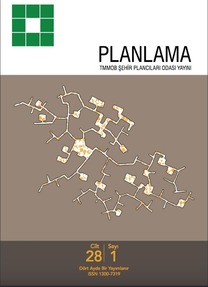Immaterial Dimensions of the Right to the City: The Case of Istanbul’s Derbent Neighborhood in the Urban Transformation Process
Kent Hakkının Maddi Olmayan Boyutları: Kentsel Dönüşüm Sürecindeki İstanbul Derbent Mahallesi Örneği
___
Albarello, L. (2007). Apprendre À Chercher, L’acteur Social et la Recherche Scientifique. Paris: De Boeck & Larcier.Attoh, K. (2011). What kind of right is the right to the city? Progress in Human Geography, 35(5), 669-685.
Avar, A. A. (2009). Lefebvre’in Üçlü - Algılanan, Tasarlanan, Yaşanan Mekân- Diyalektiği. Mimarlık Dergisi, Aralık, 7-17.
Balzarini, J. S., Anne;. (2015). Gentrification and the Right to rhe City: Community Conflict and Casinos. Journal of Urban Affairs, 00(0), 1-15.
Bayat, A. (2008). Sokak Siyaseti: İran’da Yoksul Halk Hareketleri S. Torlak (Trs), . Ankara: Phoenix Yayınları.
Zizek, S. (2009). Matrix: Ya da Sapkınlığın İki Yüzü. Bahadır Turan (Trs.). İstanbul: Encore.
Bayat, A. (2010). Life as Politics: How Ordinary People Change the Middle East. Amsterdam: Amsterdam University Press.
Baysal, C. (2011). Kent Hakkı Yeniden Hayat Bulurken. Eğitim Bilim Toplum, 9(36), 31-55.
Buds, J., & Teixeira, P. (2005). Ensuring the Right to the City: Pro-poor housing, urban development and tenure legalization in São Paulo, Brazil. Environment and Urbanization, 17(1). 89-113
Charmes, E. (2005). Le Retour À La Rue Comme Support De La Gentirifcation. Espaces Et Sociétés, 122, 115-135.
Davis, D., Moore, N., Wright, M., & Zykofsky, P. (2013). Participation Tools for Better Community Planning. Sacramento: Local Government Commission.
Davis, M. (2006). Planet of Slums. London - Newyork: Verso Publication.
De Souza, M. L. (2011). Hangi Kentte Hangi Hak? Politik-Stratejik Netliğin Müdaafası. Education Science Society Journal, 9(36). 183-207.
Friedmann, J. D., M; (Ed.). (1998). Cities for Citizens: Planning and the Rise of Civil Society in a Global Age. New York: Wiley.
Gönen, Z. (2008). Varoşların Zabtiyesi ya da Kent Yoksullarının Neoliberal Denetimi. ToplumBilim, 23, 93-103.
Harvey, D. (2000). Spaces of hope. Berkeley Los Angeles: University of California Press.
Harvey, D. (2008). Right To The City. New Left Review, 53(September-October). Retrieved from New Left Review website: http://newleftreview. org/II/53/david-harvey-the-right-to-the-city
Harvey, D. (2012). Rebel Cities: From the Right to the City to Urban Revolution. London: Verso Pub.
Konuk, M. (2011). Mahalle: Bir Kimlikler Kavşağı. Toplum Bilim, 26(Nisan 2011), 75-82.
Kurtulus, H., & Turkun, A. (2005). Giriş. In H. Kurtuluş (Ed.), İstanbul’da Kentsel Ayrışma: Mekânsal Dönüşümde Farklı Boyutlar. İstanbul: Bağlam Yayınları
Kuyucu, T. Ü., Özlem;. (2010). Urban Transformation as State Led Property Transfer: An Analyses of Two Cases of Urban Renewal in Istanbul. Urban Studies, 47(7), 1479-1499.
Langegger, S. K., Stephen;. (2016). Invisible homelessness: anonymity, exposure, and the right to the city. Urban Geography, 37(7), 1030 - 1048.
Lefebvre, H. (1958). Critique de la vie quotidienne 1 Introduction (2nd ed.). Paris: l’Arche.
Lefebvre, H. (1968). La vie quotidienne dans le monde moderne. Paris: Gallimard.
Lefebvre, H. (1991). Production of Space. Oxford: Blackwell Publication. D. Nicholson-Smith (Trs.). (1st ed. 1974)
Lefebvre, H. (1996). Writings On Cities. Oxford: Blackwell Publication. E. Kofman, E. Lebas (Trs.). (1st ed. 1996)
Marcuse, P. (2012). From Critical Urban Theory to the Right to the City. In N. Brenner, Peter Marcuse, and Margit Mayer (Ed.), Cities for People, Not for Profit: Critical Urban Theory and the Right to the City. New York: Routledge
Masuda, J. B., Sonia;. (2016). Neighbourhood branding and the right to the city. Progress in Human Geography, 1-18.
Mayer, M. (2011). Kentsel Toplumsal Hareketlerde Kent Hakkı. Eğitim Bilim Toplum, 9(6). 153-182.
McCann, E. (2002). Space, Citizenship and the Right to the City: A Brief Overview. GeoJournal, 58. 77-79.
Mitchell, D. (2003). The Right to the City. New York: Guilford Publications.
Pérouse, J. F., & Danış, D. (2005). La Politique Migratoire Turque: Vers Une Normalisation? Migrations Société, 17(98).
Pétonnet, C. (1985). On Est Tous Dans Le Brouillard. Paris: Editions Gallilée.
Pierce, J., Williams, O., & Martin, D. (2016). Rights in places: An analytical extension of the right to the city. Geoforum, 70, 79-88.
Purcell, M. (2002). Excavating Lefebvre: Right to the city and its urban politics of the Inhabitant. GeoJournal, 58(2/3).
Purcell, M. (2003). Citizenship and the Right to the Global City: Reimagining the Capitalist World Order. International Journal of Urban and Regional Research, 27(3), 564-590.
Sayad, A. (1998). Un Nanterre Algérien, Terre de Bidonvilles. Paris: Autrement.
Sen;, B., & Doğan, A. E. (2010). Neoliberalizm Mekânı ve Mücadele Deneyimleri Tarih, Sınıflar ve Kent. İstanbul: Dipnot Yayınları
Şen, B. (2006). Kentsel Gerilemeyi Aşmada Çelişkili Bir Süreç Olarak Soylulaştırma: Galta Örneği. (Doktora), Mimar Sinan Güzel Sanatlar Üniversitesi, İstanbul
Yalçıntan, M. C., Çılgın, K., & Çalışkan, Ç. (2012). İstanbul Dönüşüm Coğrafyası 3. Kentsel ve Bölgesel Araştırmalar Sempozyumu (Kent, Bölgeler, Metropoliten Alanlar, Büyükşehirler: Değişen Dinamikler ve Sorunlar). 294-312. Ankara: Kentsel ve Bölgesel Araştırmalar Ağı
Yücel, D., & Akı, M. (2012). Kentsel Politik Ekoloji Bağlamında Farklı Doğa Tahayyüllerinde Sosyo-Ekolojik İlişkiler: Gecekondu Mahallesi-Kapalı Site Karşılaştırması. In A. D. E. Mim Sertaç Tümtaş, Cem Ergun (Ed.), Kente Dair. İstanbul: Bağlam Yayınları
Yücel, H. (2005). Les jeunes alévis du quartier de Gazi (Istanbul) et les associations de hemşehri : identifications croisées. European Journal of Turkish Studies, Hometown Organisations. URL: http://journals.openedition. org/ejts/406
- ISSN: 1300-7319
- Yayın Aralığı: 3
- Başlangıç: 1986
- Yayıncı: TMMOB Şehir Plancıları Odası
Türk Otomotiv Endüstrisinde Dayanıklılık, Perçin Etkisi ve Üretim Zincirlerinin Değişen Coğrafyası
Kent Planlama ve Kentsel Altyapı İlişkisinin Evrimi
Bölgesel Gelişmişlik Düzeyinin Belirlenmesine İlişkin Veri Seti Sorunsalı: Eleştiri ve Öneriler
Sinem Dedeoğlu ÖZKAN, Dilek BEYAZLI
Kültürel Peyzajların Tarihsel Süreç İçerisindeki Değişimlerinin Tespiti: Bursa İznik Örneği
Seher Demet KAP YÜCEL, Esra SALT
Ali Kemal ÇINAR, Mehmet PENPECİOĞLU
Gizem AKSÜMER, Mehmet Hakan YÜCEL
Kent Hakkının Maddi Olmayan Boyutları: Kentsel Dönüşüm Sürecindeki İstanbul Derbent Mahallesi Örneği
